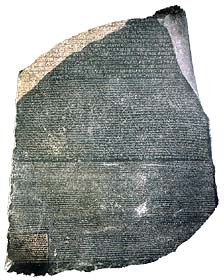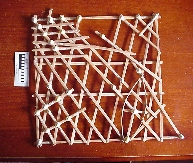- HOME
- VISIT
- ABOUT
- TOURS
- VISITOR FAQs
- LOCAL RESOURCES
- FAST FACTS
- MOAH HISTORY
- WILLIAMS HOUSE
- VICTORY GARDEN
- BOARD AND STAFF
- EXHIBITS
- CURRENT EXHIBIT
- PERMANENT EXHIBITS
- FUTURE EXHIBITS
- PAST EXHIBITS
- ARCHIVED EXHIBITS
- COLLECTION
- COLLECTION HISTORY
- DONATE TO THE COLLECTION
- SEARCH COLLECTION
- PROGRAMS & EVENTS
- CALENDAR
- ADULT PROGRAMS
- CHILDREN'S PROGRAMS
- ANNUAL EVENTS
- PAST EVENTS
- SPECIAL EVENTS
- GET INVOLVED
- MEMBERSHIP
- VOLUNTEER
- GIFT OPPORTUNITIES
- STAY CONNECTED
- EMAIL SIGNUP
- NEWSLETTERS
- PRESS
- Membership Response
Information Storage in the Classical Period: 1000 BC to 1000 AD
Information storage in the period of Greek and Roman ascendancy was characterized by increased use of alphabets and the development of sophisticated techniques of image creation in stone, wood, ceramics and soft media, such as animal skins and papyrus. Wax tablets were frequently used in schools, perhaps because they could be erased and reused.Symbols and accents
In addition to letters, writers use punctuation marks such as a period to show where a sentence ends. Some languages, such as French, also use accents - marks that show how to pronounce the word.
Modern alphabets
The alphabet used in English and other European languages is based on the Roman alphabet, which had 23 letters. This alphabet is also used in some Far Eastern languages, such as Vietnamese and Indonesian. The first Roman alphabet had only capital letters. Small letters started to appear after the 8th century.
The Roman alphabet is only one of the world's alphabets. Many other languages use different symbols to represent similar sounds, and the words may be written and read quite differently. Hebrew and Arabic, for instance, have their own letters and symbols, and are normally read right to left, instead of left to right. Japanese readers (who use a combination of pictographs and alphabet-like symbols representing syllables) may start at the top right and read down the page and to the left. Left to right writing is also used.
The Rosetta Stone
 When soldiers of Napoleon's army invaded Egypt in 1798, they discovered (in 1799) a fragment
of a stone block inscribed in three languages: Egyption hieroglyphic, Demotic
(a simplified form of hieroglyphic) and Greek. The three inscriptions had the same
meaning, and served as a key to the translation of hieroglyphic writing, which up
to that time had been very difficult to interpret. The stone was created in 322 BC
or later, sometime after the arrival of Alexander the Great in Egypt. Some parts of
the stone are missing, but the same inscriptions have been found elsewhere, allowing
a complete record of the original content. The translation of the inscription (which
included a royal decree that the inscription be recorded in the three lanuages) was
completed in the first part of the 19th century.
When soldiers of Napoleon's army invaded Egypt in 1798, they discovered (in 1799) a fragment
of a stone block inscribed in three languages: Egyption hieroglyphic, Demotic
(a simplified form of hieroglyphic) and Greek. The three inscriptions had the same
meaning, and served as a key to the translation of hieroglyphic writing, which up
to that time had been very difficult to interpret. The stone was created in 322 BC
or later, sometime after the arrival of Alexander the Great in Egypt. Some parts of
the stone are missing, but the same inscriptions have been found elsewhere, allowing
a complete record of the original content. The translation of the inscription (which
included a royal decree that the inscription be recorded in the three lanuages) was
completed in the first part of the 19th century.
Wanted: Digital Rosetta Stone
The computer systems market has grown and evolved so rapidly that many forms and formats of storage existed as products for a relatively short time. While the records stored on tape, disk, and other media may still exist, the mechanisms to play back the data were sent to the scrap yard years ago. And the skilled technicians to repair those mechanisms are long since retired or have moved on to other endeavors. Recovery of data from obsolete media formats is a formidable problem, especially if the product originally used to make the recording was not an industry standard. To further complicate the situation, much of the recorded data tends to degrade with time, either because the media used decays or because of inadvertent over-writing or modification of data.
While paper records can survive for centuries, much of the digital record of the 20th century may well be lost to future researchers for lack of compatible playback equipment.
The Abacus
 The abacus and its variants are hand operated, mechanical counting devices used for
computation, usually addition and subtraction, though multiplication and division are
also possible. "Abacus" is from the Greek abak/abax which means slab.
The abacus and its variants are hand operated, mechanical counting devices used for
computation, usually addition and subtraction, though multiplication and division are
also possible. "Abacus" is from the Greek abak/abax which means slab.
The abacus originated in ancient Mesopatamia as a board upon which lines of dust were piled. Marks on the lines were used to count. It was improved by the Greeks and Romans, who used a scribed board and pebbles in much the same way. The Roman abacus evolved into a board grooved with two sets of columns, upper and lower. This design was adopted by the Chinese as the suan-pan, modified by changing the grooves to wires containing sliding beads by 500 AD. The abacus migrated to Japan by 1500, where by the late nineteenth century it had evolved into the soroban. The Aztecs also had an abacus, the nagual, which appeared about 950 AD.
Versions of the abacus continue in use today, notably in Asian homes and businesses or in situations where use of a mechanical or electronic calculator is difficult. Once trained, users find it handy and convenient. Its use is often taught in Asian schools. Finding a desk containing a computer and an abacus is not unusual. Batteries not required!
Abacus styles.
The Chinese suan-pan divides each column into two groups of beads, 2 above and 5 below. The Japanese Soroban has columns with one upper bead and 4 lower beads. And the Aztec nagual uses a 4/3 combination. Each device required a different computation technique.
Stick charts
 Canoe voyages across the Western Pacific may have begun over 2000 years ago.
Beginning about 700 AD, Polynesians began making routine journeys of hundreds or thousands
of miles across the Pacific, finding their way by observing the stars, wave patterns
and cloud formations. The navigators who directed these voyages were specially trained
and used a variety of devices to aid their memories as to typical wave patterns and other
phenomena found at specific points on a journey. The stick chart shown in the illustration
is a representation of wave patterns caused by the refraction and reflection of long
ocean swells from islands. Used by Marshall Islanders, it is a form of graphical
information storage. Other devices were used for navigation by celestial objects.
Canoe voyages across the Western Pacific may have begun over 2000 years ago.
Beginning about 700 AD, Polynesians began making routine journeys of hundreds or thousands
of miles across the Pacific, finding their way by observing the stars, wave patterns
and cloud formations. The navigators who directed these voyages were specially trained
and used a variety of devices to aid their memories as to typical wave patterns and other
phenomena found at specific points on a journey. The stick chart shown in the illustration
is a representation of wave patterns caused by the refraction and reflection of long
ocean swells from islands. Used by Marshall Islanders, it is a form of graphical
information storage. Other devices were used for navigation by celestial objects.

|
This page
last updated: May 6, 2010 Original content: Copyright © 2000, 2001, 2002-2010 Museum of American Heritage Trademarks are the property of their owners |
 |
Join today! Membership dues help sustain MOAH. For more information and to download a Membership Form
LEARN MORE HERE
For questions and comments
Contact Us.
Mailing Address
PO Box 1731, Palo Alto, CA 94302
351 Homer Avenue
Palo Alto, California
p. 650.321.1004
e.



